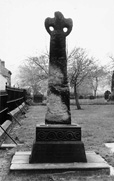Select a site alphabetically from the choices shown in the box below. Alternatively, browse sculptural examples using the Forward/Back buttons.
Chapters for this volume, along with copies of original in-text images, are available here.
Object type: Cross-shaft and part of -head (the 'Giant's Thumb')
Measurements:
Total height: 196 cm (77 in)
Head: H. 46 cm (18 in); W. 50 cm (19.7 in); D. 14 cm (5.5 in)
Shaft: H. 153 cm (60.2 in); W. 42.5 > 25 cm (16.7 > 9.8 in); D. 20.5 cm (8 in)
Stone type: Medium-grained, micaceous red sandstone (Carboniferous?)
Plate numbers in printed volume: 484 - 8
Corpus volume reference: Vol 2 p. 135-136
(There may be more views or larger images available for this item. Click on the thumbnail image to view.)
Cross-head, type B9, with ring, type 1(a); rectangular shouldered shaft, type d. The head and all faces of the shaft are bordered by a roll moulding.
A (broad): Traces of interlace decoration on the head. Below, on the shaft, is further interlace decoration which Collingwood reconstructed as Como-braid; this detail is no longer clear. Immediately underneath, though with no panel division, is a worn Crucifixion scene with Sol and Luna above the arms of the cross. At the base of the panel is scrollwork organized in an inorganic manner.
B (narrow): Interlace, five registers of simple pattern F with long glides in a single full-length panel with drilled holes emphasizing the crossing points. The form of the lower terminal register is uncertain.
C (broad): No visible decoration now exists on the head or the upper part of the shaft. At the centre of the shaft is a heavily worn figure set within an arched and cabled frame. Beneath are traces of plait.
D (narrow): A stripped rendering of a running spiral scroll.
The outline of the cross indicates that it can be classified as a round-shaft derivative. Indeed its profile exactly matches that of the western shaft (no. 5) of the nearby 'Giant's Grave'. The placing of the figure on face C beneath an arched frame which is distinct from the border moulding follows a north-western pattern in the Viking period (see p. 00). The presence of Sol and Luna on the Crucifixion scene reflects earlier Anglian usage.



